Themed collection Detection of contaminants in food

Nanotechnology-based approaches for food sensing and packaging applications
The advancement of nanotechnology has provided opportunities for the development of new sensing and food packaging solutions, addressing long-standing challenges to extend shelf-life, reduce waste, assess safety and improve the quality of food.
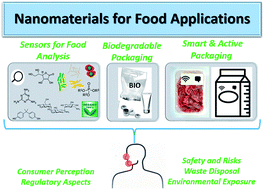
RSC Adv., 2020,10, 19309-19336
https://doi.org/10.1039/D0RA01084G
A review on graphene-based nanocomposites for electrochemical and fluorescent biosensors
Biosensors with high sensitivity, selectivity and a low limit of detection, reaching nano/picomolar concentrations of biomolecules, are important to the medical sciences and healthcare industry for evaluating physiological and metabolic parameters.
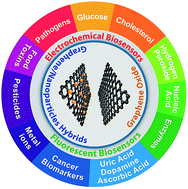
RSC Adv., 2019,9, 8778-8881
https://doi.org/10.1039/C8RA09577A
Biofilm formation and control strategies of foodborne pathogens: food safety perspectives
Foodborne pathogens are the main factors behind foodborne diseases and food poisoning and thus pose a great threat to food safety.
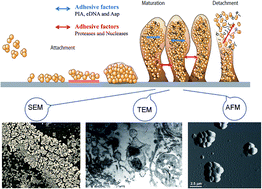
RSC Adv., 2017,7, 36670-36683
https://doi.org/10.1039/C7RA02497E
Dispersive and FT-Raman spectroscopic methods in food analysis
Raman spectroscopy is a powerful technique for molecular analysis of food samples.

RSC Adv., 2015,5, 56606-56624
https://doi.org/10.1039/C4RA12463D
Chemical sensors and biosensors for the detection of melamine
Melamine is an emerging contaminant in milk, infant formula and pet food.
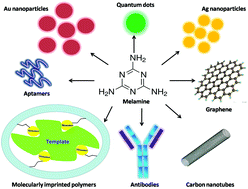
RSC Adv., 2015,5, 1125-1147
https://doi.org/10.1039/C4RA13080D
Nanomaterials-based electrochemical detection of chemical contaminants
Recent advances in the development of nanomaterials-based electrochemical sensors for environmental monitoring and food safety applications are assessed.

RSC Adv., 2014,4, 63741-63760
https://doi.org/10.1039/C4RA10399H
NMR-based metabolomics with enhanced sensitivity
We combined Spin Noise Tuning Optimum (SNTO) and electric field component-optimized shaped tube to boost sensitivity for NMR-based metabolomics.
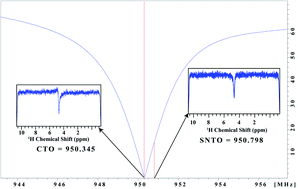
RSC Adv., 2021,11, 8694-8700
https://doi.org/10.1039/D1RA01103K
CdTe QD-based inhibition and reactivation assay of acetylcholinesterase for the detection of organophosphorus pesticides
An enzyme immobilized glutathione (GSH)-capped CdTe quantum dot (QD)-based fluorescence assay has been developed for monitoring organophosphate pesticides.

RSC Adv., 2020,10, 24190-24202
https://doi.org/10.1039/D0RA03055D
Coupling of digital image processing and three-way calibration to assist a paper-based sensor for determination of nitrite in food samples
In this work, a novel and very interesting analytical methodology based on coupling of digital image processing and three-way calibration has been developed for determination of nitrite in food samples.
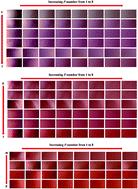
RSC Adv., 2020,10, 14422-14430
https://doi.org/10.1039/C9RA10918H
Microfluidic paper device for rapid detection of aflatoxin B1 using an aptamer based colorimetric assay
Contamination of milk by mycotoxins is a serious problem worldwide.
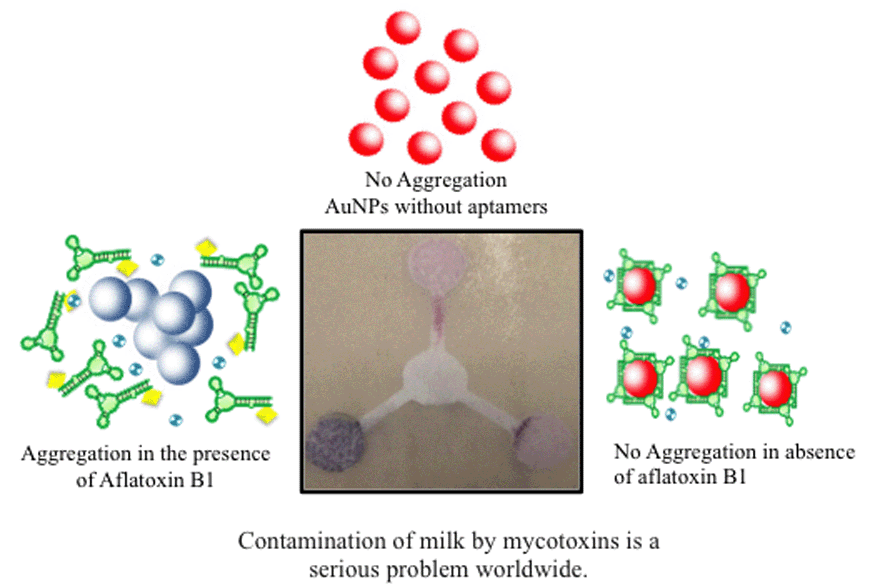
RSC Adv., 2020,10, 11843-11850
https://doi.org/10.1039/D0RA00062K
Facile construction of magnetic core–shell covalent organic frameworks as efficient solid-phase extraction adsorbents for highly sensitive determination of sulfonamide residues against complex food sample matrices
Robust and efficient solid-phase extraction adsorbents based on magnetic core–shell covalent organic frameworks gave excellent analytical performance for determination of sulfonamide residues in food samples.

RSC Adv., 2019,9, 14247-14253
https://doi.org/10.1039/C9RA01879D
A water-stable luminescent metal–organic framework for effective detection of aflatoxin B1 in walnut and almond beverages
Sensitive and rapid detection of aflatoxin B1 (AFB1) without using antibody or biomolecular modifications in water is achieved using a novel water-stable luminescent metal–organic framework (LMOF) termed Zr-CAU-24.
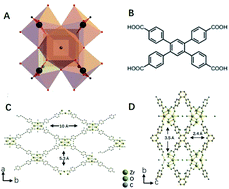
RSC Adv., 2019,9, 620-625
https://doi.org/10.1039/C8RA07804A
Development of a FRET-based fluorescence aptasensor for the detection of aflatoxin B1 in contaminated food grain samples
The present study aimed to develop an aptamer-based FRET detection strategy for the specific and sensitive detection of AFB1 in contaminated food grains.
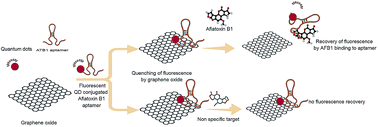
RSC Adv., 2018,8, 10465-10473
https://doi.org/10.1039/C8RA00317C
An electrodeposited molecularly imprinted quartz crystal microbalance sensor sensitized with AuNPs and rGO material for highly selective and sensitive detection of amantadine
In the present work, a new amantadine imprinted quartz crystal microbalance sensor sensitized by Au nanoparticles and reduced graphene oxide material was fabricated by electrodeposition of o-aminothiophenol by cyclic voltammetry scanning.
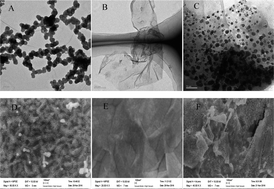
RSC Adv., 2018,8, 6600-6607
https://doi.org/10.1039/C7RA09958D
Colorimetric detection of streptomycin in milk based on peroxidase-mimicking catalytic activity of gold nanoparticles
A novel and effective colorimetric aptasensor based on enhanced peroxidase-mimicking catalytic ability of AuNPs was proposed for streptomycin detection.

RSC Adv., 2017,7, 38471-38478
https://doi.org/10.1039/C7RA06434A
A novel impedimetric aptasensor based on AuNPs–carboxylic porous carbon for the ultrasensitive detection of ochratoxin A
A novel impedimetric aptasensor based on AuNPs–carboxylic porous carbon for the ultrasensitive detection of OTA.

RSC Adv., 2017,7, 28655-28660
https://doi.org/10.1039/C7RA04209D
CdTe/CdS quantum dot-labeled fluorescent immunochromatography test strips for rapid detection of Escherichia coli O157:H7
Immunochromatography test strips have been widely used to detect foodborne pathogens due to their high sensitivity, stability and specificity, and the selection of the label is an important factor.

RSC Adv., 2017,7, 17819-17823
https://doi.org/10.1039/C7RA00821J
An ultrasensitive aptasensor for chlorpyrifos based on ordered mesoporous carbon/ferrocene hybrid multiwalled carbon nanotubes
In this study, we designed a novel and ultrasensitive aptamer sensor for the quantitative detection of chlorpyrifos.

RSC Adv., 2016,6, 58541-58548
https://doi.org/10.1039/C6RA07735H
Detection and quantification of food colorant adulteration in saffron sample using chemometric analysis of FT-IR spectra
The aim of present study is to investigate the combination of Fourier transform infrared spectroscopy with pattern recognition to recognize the standard saffron from those which have been adulterated with various types of food colorants.

RSC Adv., 2016,6, 23085-23093
https://doi.org/10.1039/C5RA25983E
Multiplex lateral flow immunoassay for five antibiotics detection based on gold nanoparticle aggregations
A new immunochromatographic assay was developed for the simultaneous screening of five antibiotics that can coexist in milk, namely lincomycin, gentamicin, kanamycin, streptomycin, and neomycin, using five corresponding monoclonal antibodies.

RSC Adv., 2016,6, 7798-7805
https://doi.org/10.1039/C5RA22583C
A nanoporous MgO based nonenzymatic electrochemical sensor for rapid screening of hydrogen peroxide in milk
In this work, a nonenzymatic electrochemical sensor based on nanoporous magnesium oxide (MgO) was developed for the rapid screening of hydrogen peroxide (H2O2) in milk.
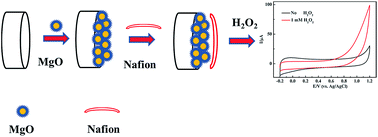
RSC Adv., 2015,5, 86485-86489
https://doi.org/10.1039/C5RA18560B
A remarkable sensitivity enhancement in a gold nanoparticle-based lateral flow immunoassay for the detection of Escherichia coli O157:H7
The size and uniformity of AuNPs were optimized to maximally amplify both visual inspection signals and quantitative data of LFA.

RSC Adv., 2015,5, 45092-45097
https://doi.org/10.1039/C5RA06237C
A sensitive electrochemical sensor for direct phoxim detection based on an electrodeposited reduced graphene oxide–gold nanocomposite
The principal objective of this study was to develop a sensitive and selective electrochemical sensor for phoxim detection based on a reduced graphene oxide–gold nanocomposite (RGO–Au) modified grassy carbon electrode (GCE).
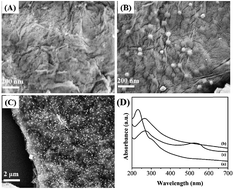
RSC Adv., 2015,5, 15425-15430
https://doi.org/10.1039/C4RA15872E
“Turn-on” fluorescent detection of cyanide based on polyamine-functionalized carbon quantum dots
A simple, sensitive, rapid fluorescence sensor has been developed to detect cyanide ions on the branched polyethylenimine-capped carbon quantum dots.
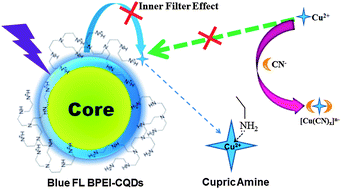
RSC Adv., 2014,4, 3701-3705
https://doi.org/10.1039/C3RA45893H
About this collection
We are very pleased to present our 10th Anniversary collection on the detection of contaminants in food!Looking back over the last 10 years, we would like to showcase some of the very best articles that have been published in RSC Advances. Many of these papers have been cited hundreds of times, providing valuable advances for further research, and some continue to be among the journal’s most downloaded articles as of today.
We hope you enjoy our 10th Anniversary collection on the detection of contaminants in food!